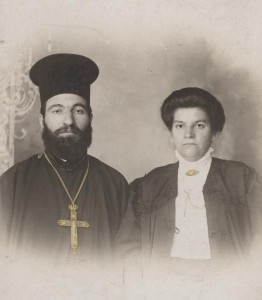From its founding in 1868, the Russian cathedral in San Francisco was a multiethnic community. In particular, Greeks and Serbs were an integral part of the church, and, at various times, there was an ethnic Greek (Fr. Kallinikos Kanellas) and an ethnic Serb priest (Fr. Sebastian Dabovich) serving the parish.
By 1903, however, the Greeks of San Francisco wanted their own church. From the San Francisco Call (1/8/1903):
While the Greek members of Bishop Tikhon’s flock have nothing but the kindest feelings toward their spiritual director and the church which has sheltered and fostered the faith of their own land, they find the Russian language, in which the church services are now conducted, a decided impediment in the way of a proper and beneficial appreciation of the good Bishop’s ministrations.
There were about 2,000 Greeks in the city at this point, and they got together and formed an association, with the aim of establishing their own, Greek-speaking church. By the end of the year, all the arrangements were in place, and Holy Trinity Church was born. (Yes, they adopted the same name as the Russian parish which they were leaving.) The community hired Fr. Constantine Tsapralis to be their priest. On November 16, Fr. Sebastian Dabovich, who was serving at the Russian cathedral, sent the following report to his bishop, St. Tikhon:
It is my duty to report to your Grace that the Greek Community in San Francisco has begun building a new church in San Francisco on a plot of land purchased south of Market Street. They ordered a priest by mail for themselves who arrived and was present today at Divine Liturgy at the Cathedral church (he was standing in the altar). This priest (married) in the rank of sakellarios, Father Constantine . . .[Tsapralis, or Chaprales] has his credentials from his Bishop, Ambrose of the Diocese of Salaris [probably, Fr. Sebastian is mistaken, it could be “Salamis”] (in the Kingdom of Greece), in the jurisdiction of the Holy Synod in Athens. He has a Holy Antimension that was given to him (he says) to celebrate Liturgy in the United States of North America. He was here with two Orthodox Greeks known to me.
On December 12, Tikhon sent a brief reply: “May God grant them all success.”
(Both Dabovich’s letter and Tikhon’s response may be found in the incomparable archive of Holy Trinity OCA Cathedral.)
As Dabovich said, Fr. Constantine Tsapralis was a married priest. In 1904, he sent for his wife and son. Tsapralis was born in about 1869, so at this point, he was in his mid-30s. Despite this, he and his wife went on to have four more children, the last of them when Fr. Constantine was in his mid-50s.
The Holy Trinity Greek Church website has a profile of Tsapralis, which includes several descriptions and vignettes. Tsapralis is described as “durable,” having pastored the parish through many difficult times, including the devastating 1906 earthquake and various schisms in the decades that followed. He’s also described as “kind and compassionate,” “a good teacher,” and “gentle with children.” Here is one story about Tsapralis:
In 1913, a Greek man named Prantikos was convicted of murder. Fr. Tsapralis was asked to go to San Quentin to administer the last rights before Prantikos was hung for his crime. The event, described in the San Francisco Call Bulletin, said that Fr. Tsapralis was reading prayers on the way to the gallows. He was described as a strong, tall man. On the gallows, his knees buckled and he wavered at the sight before him. The prison chaplain put his arm around him to support him because he was worried that he might fall through the gallows. Fr. Tsapralis continued reading prayers and he witnessed the hanging. The prison chaplain later described him as a kind, gentle soul.
I found another story about Tsapralis that doesn’t appear on the Holy Trinity website. For several years in the early 1900s, Tsapralis had owned and operated a candy store, which has also been described as a “saloon.” If it really was a saloon (in the sense that we understand it), this would be uncanonical — an Orthodox priest is expressly forbidden from operating a drinking establishment. Eventually, Tsapralis sold the place… to his wife! The Morning Oregonian (11/18/1911) reported, “But before selling he neglected to liquidate a bill of $300 for a soda fountain and other fixtures in the shop. A collection agency sued, and, securing judgment, had an execution issued against the candy store.” The sheriff came and seized store property, but Mrs. Tsapralis protested, arguing that the store was her property, not her husband’s. The case went to court, and Fr. Constantine admitted having owned the store. I don’t know how the case turned out.
Anyway, after Fr. Constantine’s wife died, he was raised to the rank of archimandrite. He served the Holy Trinity community for more than three decades, finally stepping down in 1936. He died in 1942, at the age of 73.

